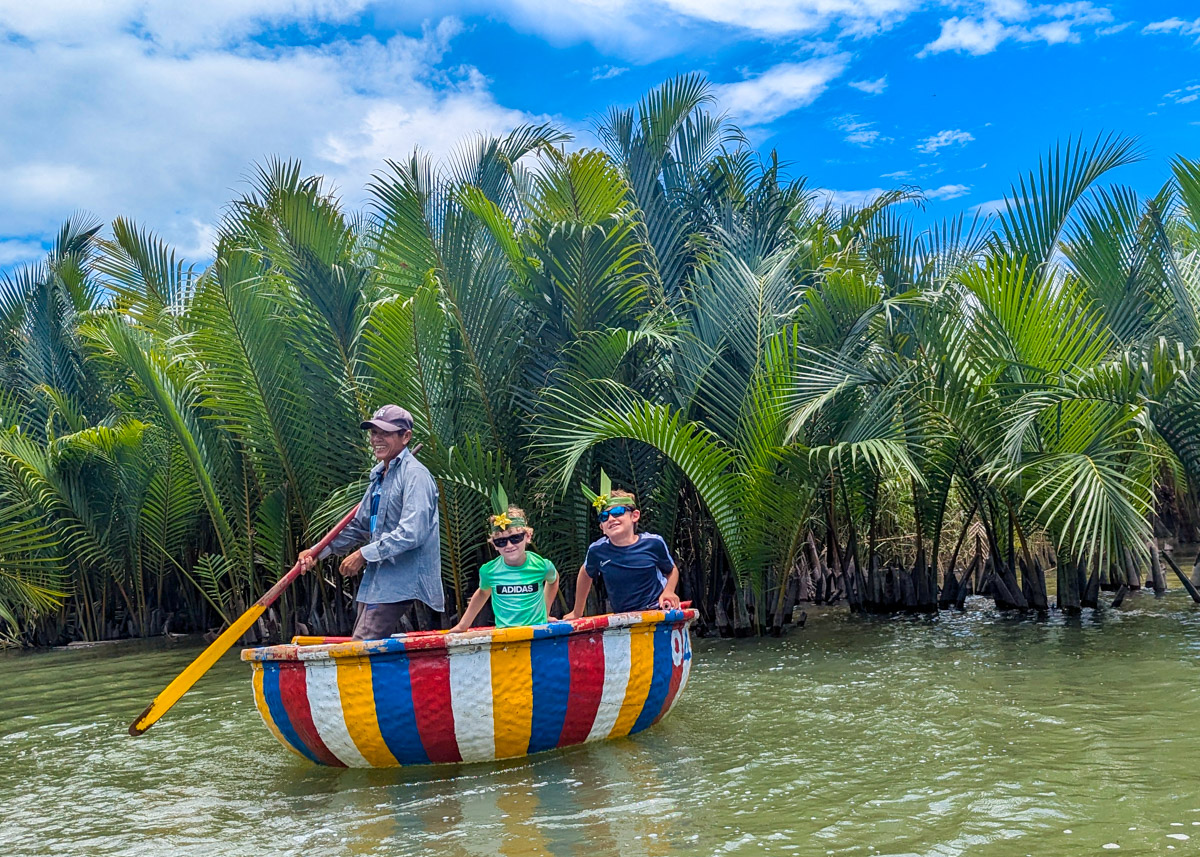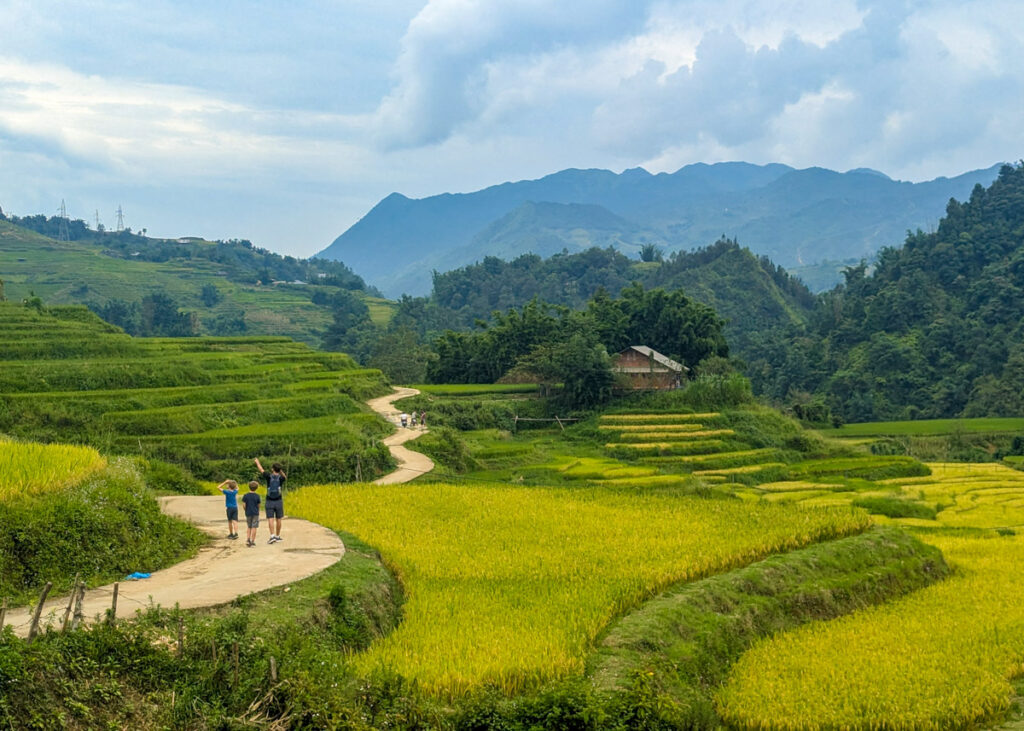Your ultimate guide to travelling Vietnam with kids from a family who spent 45 days overlanding from HCMC to Hanoi.
As an introduction into Southeast Asia, very few countries in the region can match the diverse and chaotic welcome you’ll receive in Vietnam. Families travelling with children can expect a warm embrace from the Vietnamese people, and the country itself is well setup to support the growing number of visiting tourists.
It’d be an understatement to say the past seventy years haven’t been without their challenges, but recent decades have seen a confident and stable country emerge. The past is still relevant to modern-day Vietnam and, if you choose to include them, there are plenty of sights and museums that bring those dark days back to life. With the correct planning and navigation, these are valuable history lessons for worldschooling kids, otherwise rest assured there’s plenty in the way of more familiar family-friendly activities including cosmopolitan cities, beach resorts, hill stations, theme parks and endless countryside views.
We spent 45 days in Vietnam and here we share our suggested five week Vietnam with kids itinerary and top tips to help you get the most out of your family visit.
Disclaimer: This post contains affiliate links. If you click to purchase, it is at no additional cost to you, and I receive a small commission.

Is Vietnam safe to travel with children?
Yes, Vietnam is a safe country to travel with children. The Vietnamese people are almost universally kind and gentle, with children nearly always taking star-billing when you arrive at a hotel or restaurant.
The biggest obstacle to a completely stress-free trip is the traffic and, to a lesser extent, the lack of usable pavements in the big cities. Crossing the road is an Olympic sport in Vietnam, with very little in the way of a gentle introduction. The first time you cross a busy Saigon street as a family is both exhilarating and terrifying. Don’t be afraid to wait for a local to help/shield you on the first few attempts but, above all, remember to avoid sudden movements, maintain eye-contact and learn that the motorists will avoid you, not the other way round.
Once you reach the other side, don’t expect an altogether easier ride as it’s common for Vietnamese pavements to be filled with motorbikes, mopeds, and food carts, turning even a gentle stroll into an obstacle course. Leave the pushchairs and buggies at home and invest in a back-carrier.
Similarly, the standard of driving is fairly poor throughout the country, so bus journeys and taxi rides are likely to be statistically more dangerous than back home, but still keep the risks in perspective.
Away from the roads and pavements, life is relaxed and safe in Vietnam, and you’re highly unlikely to be a witness or victim to any form of crime, violent or otherwise. All the usual precautions you’d follow around the world are applicable here though, such as hiding valuables away, investing in a money belt and staying away from dark alleyways late at night. Bag or mobile phone snatching does occur in some cities, so keep them hidden from sight and away from the roadside.
How to get around Vietnam with kids
Grab
Grab continues to solidify its foothold in Southeast Asia, and Vietnam is no exception. It didn’t come as a surprise that Grabs are universal in the towns and cities, but we didn’t expect it to be so easy to book a ride out in the countryside (e.g. from our homestay in the Sapa countryside), or for a two-hour drive to the Cu Chi Tunnels from Saigon.
Grabs are easy to book using the app and there are no worries about negotiating fares, explaining where you’re going, or waiting at the side of the road for an available taxi to appear. For travelling families, it really has removed one of the major hassle factors of getting around a country. If you’ve already installed Grab in another country, it’ll work out of the box here. You’ll just need to get online to book your ride but make sure you don’t rely on wifi, which will cut out just when you need it. It’s a good idea to get a local physical SIM (or an eSIM) to ensure you’re never offline when you need to book.
Bus
Vietnam is home to some of the best long-distance buses in Southeast Asia, largely because the sleeper variety is in common use, even for shorter daytime journeys. With flat beds, pillows, blankets, privacy curtains, free water and wifi, the sleeper buses are usually a highly comfortable and enjoyable way to travel.
The wide range of bus types can be quite confusing and it’s often the case that several different options are available for the same route. Try not to be fooled by the descriptions of the buses: names such as ‘VIP’, ‘Express’, ‘Deluxe’ are usually doing quite a lot of heavy lifting. In general, the fewer seats on the bus, the higher the quality.

Our favourite type was ‘VIP Cabin‘, which only has two columns of seats (as opposed to the more common three columns) and fewer rows. This equates to a much wider and longer bed (close to 180cm), meaning even taller travellers can stretch out. Kids will feel like they’re in business class.
It’s quite difficult to know in advance what standard of bus is going to appear, some bus companies are better than others, but the quality can also vary within the same company. We only had one bad journey (between Mui Ne and Dalat) with broken seat reclines, narrow cramped beds, and no curtains.
Some of the routes in Vietnam (e.g. to/from Dalat or Sapa) follow narrow, winding roads for large parts of the journey, so travel sickness can be an issue. Don’t make the same mistake we did by booking the rear seats, it’s a lot smoother if you’re sat near the front or the middle. The lower bunks are also popular for this reason, and they’re sometimes more expensive than the upper berths as a result.
We wouldn’t recommend sleeper buses for overnight journeys, partly from a road-safety perspective and partly because the constant cycle of acceleration and braking (with a honk of the horn thrown in for good measure), doesn’t make for a peaceful night’s sleep.
Buses can be booked online (click here to book via the recommended 12Go site) but not all companies allow you to reserve seats, which can be a problem when travelling as a family. In this case, it’s recommended that you enquire at your accommodation or a nearby tour company and see if they can book the bus on your behalf. You might end up paying a small commission, but they’ll often be able to telephone the bus company and reserve seats there and then. For us, this peace of mind is worth a few thousand dong.
Alternatively, if you book via Baolau then you’ll be able to select seats, but they tend to have fewer services available.
One last point: in the majority of cases, you won’t board your bus at a large bus station but instead be directed to the company’s city centre office. This sometimes means that waiting areas and facilities aren’t the best, and information can be difficult to access once you arrive. Give yourself plenty of time and double-check the pickup address.
Train
The North-South railway line in Vietnam is a source of pride in the country and should be your default option for longer journeys, especially if you’re travelling overnight. The entire journey from Hanoi to Saigon takes upwards of thirty-six hours, but most travellers break the journey into several, smaller hops. There are also branch lines out from Hanoi towards Sapa, Halong Bay, and China.
Seats can be booked online and we found Baolau to be the best website for researching, checking availability and reserving seats. Unlike with the sleeper buses, the Baolau site has access to the official Vietnam Railways booking engine, so you can select seats and receive (almost) instant confirmation.
Click here to book train tickets via Baolau or use the handy form below.
Booking opens up to 90 days before departure, but the exacts rules governing booking windows are complex, dependent on the route you’ve selected and how long the journey is. In general, unless it’s peak holiday season, you should be able to book a compartment a few days in advance but do try and book as early as your schedule allows.
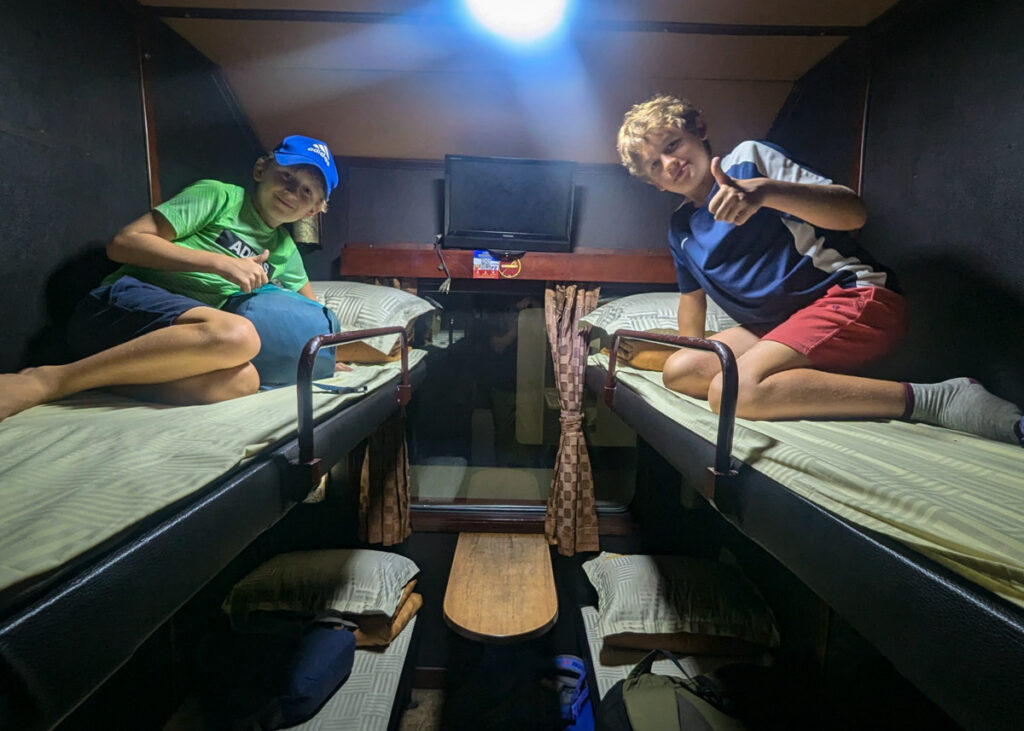
For travelling families, the four and six berth compartments are the ideal option, providing a safe, comfortable and private journey. For overnight journeys they’re ideal, and the only option we’d suggest you consider. The gentle rocking motion of the train soon sends you all to sleep, and the view from the window at first light is always the perfect wake-up call.
Most trains also have at least one carriage with normal seating (i.e. rows of upright seats). Unless it’s a very short leg, we’d recommend avoiding these carriages and booking into a private compartment instead. The seating carriage was slightly overcrowded and chaotic when we researched it, and the small extra cost of a private compartment is well worth the investment in our opinion.
Food is limited on the trains, a trolley is occasionally wheeled along the corridor, but don’t expect much beyond crisps, water and biscuits. On some of the premium services (e.g. SE1/SE2), you’ll find a restaurant car is attached and online ordering available, but the standard isn’t anything special.
It’s best to stock up at the stations beforehand, ideally at a local restaurant nearby. The stations themselves are fairly bland and basic, with limited seating and ineffective air-conditioning. Don’t arrive too early, the trains are infrequent in Vietnam, so the station staff only really come to life ten minutes before arrival.
Motorbike
If you’d prefer a slightly more authentic Vietnamese travelling experience, there’s nothing better than seeing the country from the back of a motorbike. Some travellers are confident enough to ride themselves but the easiest and most relaxing approach is to book yourself onto a tour. It’s a fantastic way to view the countryside, and you’ll see some sights along the way rather than going from A to B on a bus or train.
We did two motorbike tours on our trip, one as a day trip around Dalat and the other from Hoi An to Hue. The boys loved every minute of both tours and we felt totally safe doing it with them.
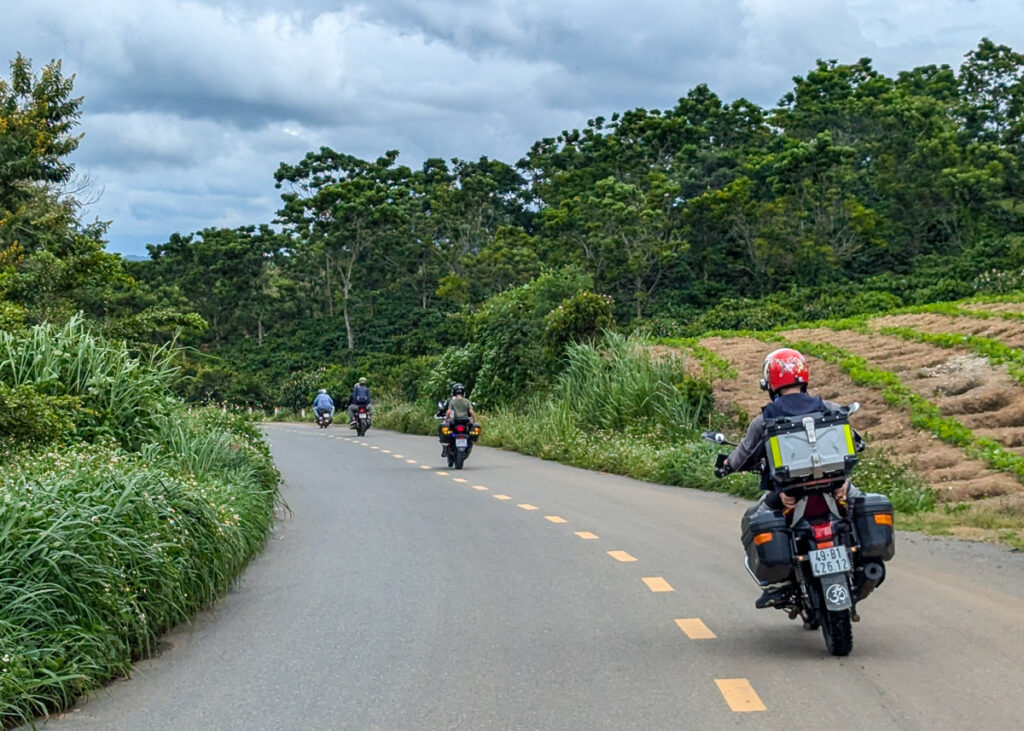
The tours can be difficult to book in person (unlike the old days), so it’s best to book online. You’ll have some control and input into the route but they mostly follow a tried and tested itinerary. Although significantly more expensive than taking public transport, the motorbike tours are recommended at least once on your Vietnam trip, you really do see a different side of the country.
Be wary of booking a multi-day tour: it might sound romantic beforehand but several hours on the back of motorbike can become tiring, and we felt ready for a proper break after just one day on the saddle.
Visas and immunisations for Vietnam
The visa situation for Vietnam is quite fluid, with changes to the rules and requirements a relatively common occurrence. In recent times, the rules have been relaxed for tourists from certain countries (including the UK, but not Australia or the US) can enter the country for 45 days without a visa if they arrive at a major airport. The situation can differ at land borders so check in advance with the Vietnamese embassy in your home country before arriving.
If 45 days isn’t long enough, or you need multiple entries, you can apply for an e-visa in advance, which is good for 90 days. Apply via the official site where you’ll find the process smooth and easy to follow.
You should check with a qualified medical professional regarding any required vaccinations for travel to Vietnam. In the UK, the excellent Fit for Travel NHS website has a range of information.
The risk of malaria is considered ‘Low to None’ in the majority of the country, including the areas tourists usually visit (e.g. along the entire coastline and around the major cities). Check this malaria map for more information and, again, take professional advice as appropriate.
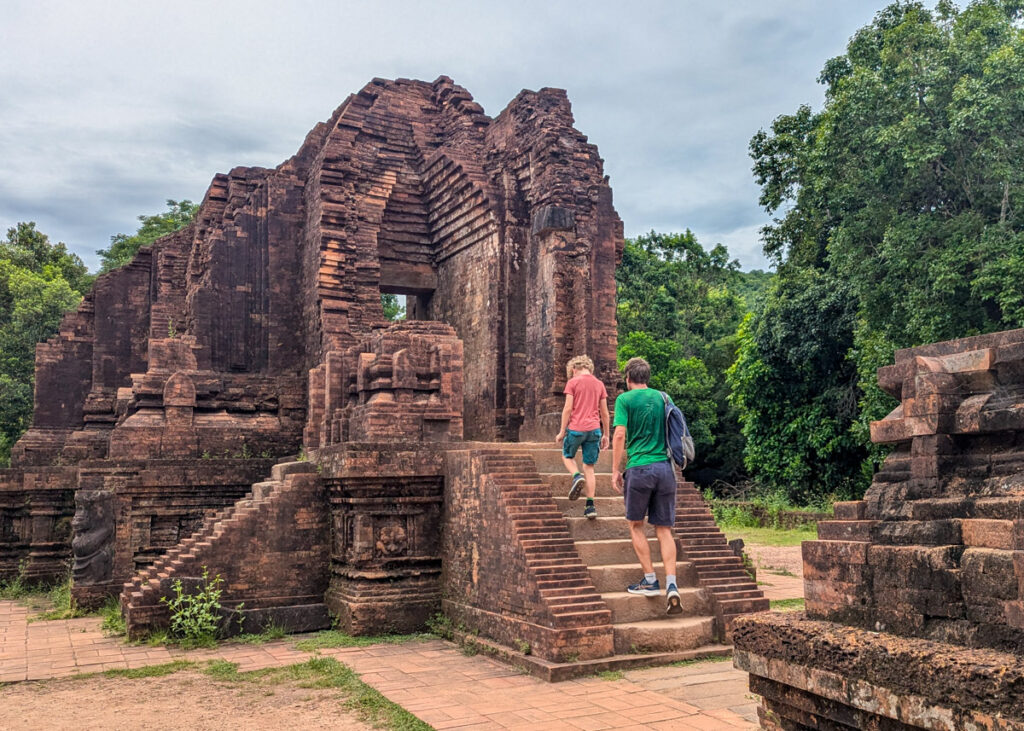
Tips for travelling Vietnam with kids
Check out our full guide for essential tips for visiting Vietnam with kids. But in summary:
- Cash is used everywhere in Vietnam, much more so than credit cards. It’s common for large tourist sites and hotels to only accept payment in cash. The exchange rate takes some getting used to (VND32,000 to the British Pound and VND25,000 to the US Dollar). Take your time to work out the exchange rate, although it’s common for prices to be quoted as (e.g.) ‘thirty’ rather than ‘thirty thousand’.
- ATMs are hit and miss, we had most success with ACB. The limit is typically around VND3,000,000 (yes, that’s three million dong, welcome to the millionaire’s club).
- Local food and drink is cheap, but expect to pay Western prices for things such as theme parks and fast-food restaurants.
- The conflict in the 1960s and 1970s is referred to here as the American War, not the Vietnam War. In official government museums, only one side of history is told so make sure your kids find out the full picture from you afterwards.
- Unlike in other Southeast Asian countries, English is very sparsely spoken or understood, especially once you’re outside Hanoi or Saigon. It’s not uncommon for hotel owners or staff at tourist sites to only speak Vietnamese. Google Translate often saves the day.
- Food in Vietnam is tasty but not spicy or bursting with flavour. It wasn’t our favourite food destination in the region, but it’s easy enough to find filling and cheap options. The free breakfasts in tourist hotels are, almost without exception, poor and to be avoided (unless you’re treating yourselves to a higher-end hotel).
- Vietnam is a deceptively large country, so don’t try and do it all. In particular, there’s no reward for rushing the length of the country, just to say you’ve seen Hanoi and Saigon. It’s best to decide whether you’ll prefer North or South Vietnam, and focus your time there.
Family packing list for Vietnam
Check out our Southeast Asia packing list as a guide, which includes details of the kids travel backpacks we recommend.
Check out our Southeast Asia packing list for families
However, for Vietnam, you may also need to consider cold weather gear if visiting North Vietnam over the colder, winter months (November to February). Indeed, snow is not uncommon in Sapa during December and January, and temperatures on the summit of Fansipan can drop below freezing. Layers are best, so pack a jumper, and waterproof jacket, scarf and beanie.
Trainers are more comfortable in the colder months than hiking sandals. And if you are planning on doing any trekking in Sapa in the warmer months, trainers are also advised as the footpaths can get rather muddy.

- For children aged 8 and up
- The backpack grows with your child thanks to VariQuick back length adjustment
- Optimal load transfer thanks to the compact hip fins
- Hydration system attachment (compatible with deuter Streamer 3.0 – not included)
- Variable fastening options thanks to material straps in a wide range of positions
Top 10 things to do in Vietnam with kids
In no particular order:
- Crawl through the Cu Chi tunnels used by the Vietcong outside of HCMC.
- Ride pillion on a motorbike around the Dalat countryside.
- Kayak the waters of Halong Bay amongst the two thousand limestone islets.
- Bathe in mud and jump off water inflatables in Phong Nha.
- Make traditional lanterns to bring home in Hoi An.
- Surf the waves at a fishing beach in Mui Ne.
- Follow our self-guided Sapa trekking route to explore the lush rice paddies and countryside of far northern Vietnam.
- Ride the Vietnam rails on an overnight sleeper train.
- Visit Train Street and take a food tour in Hanoi.
- Row a traditional boat around the waterways of Ninh Binh.
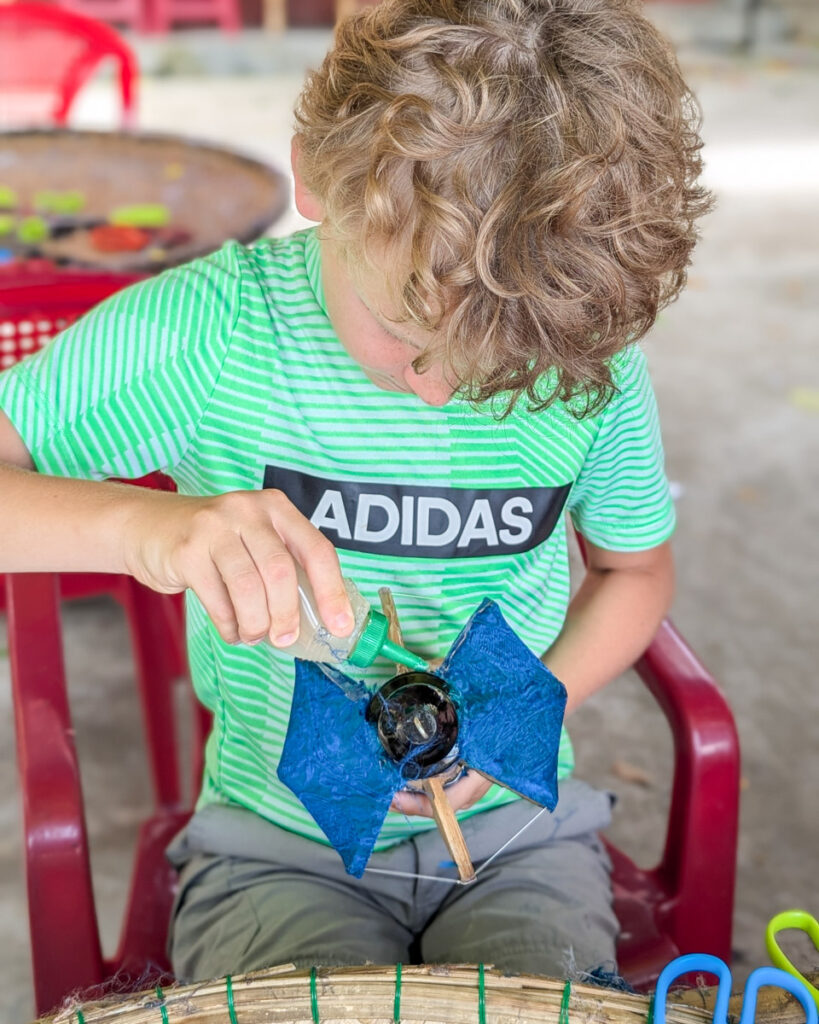


Five week Vietnam with kids itinerary
We spent 45 days travelling Vietnam with kids overland from HCMC to Hanoi but we have condensed this into a five week itinerary, which we feel is the minimum amount of time required to complete the length of Vietnam. It’s always a good idea though when backpacking with kids to keep a few extra downtime days up your sleeve so, if your schedule allows it, we’d recommend setting aside six weeks for this trip and add in some more chill days.
However, if you are short on time, we would recommend choosing between North and South Vietnam, allowing for about 2-3 weeks for each half.
This itinerary doesn’t including venturing south of Ho Chi Minh City to the Mekong Delta and Phu Quoc. If this is the region of Vietnam that interests you, please check out our 10-day South Vietnam itinerary.
Finally, this Vietnam itinerary with kids can obviously be reversed (Hanoi to HCMC). However, our personal highlights of Vietnam were actually in the north of the country, and it’s always a good idea to save the best until last. Indeed, Sapa, is our favourite place in all of Vietnam and was the perfect end to our backpacking adventures.
Day 1-3: Ho Chi Minh City
READ: Visiting Ho Chi Minh City with kids
Accommodation: Alagon City Hotel & Spa
Good location, includes decent breakfast, rooftop pool, clean and comfortable.
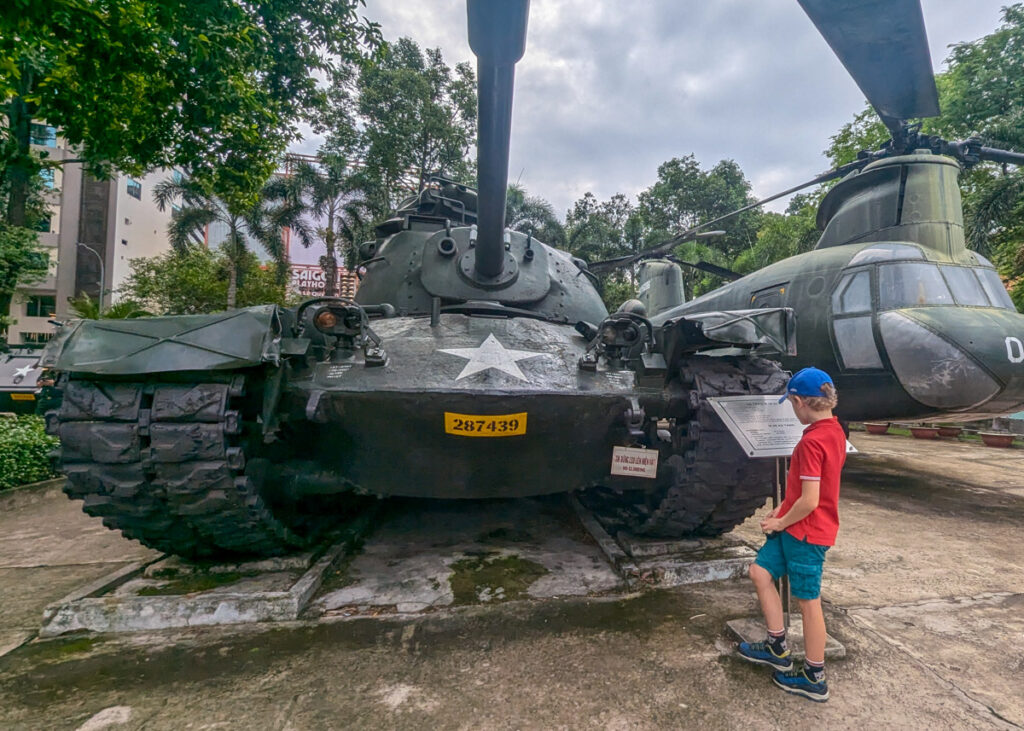
Ho Chi Minh City (formerly known as Saigon) is the largest city in Vietnam and the place many adventures around the country begin and end. Although Saigon is packed full of family-friendly activities, it also has its share of challenging sights, some of which aren’t obviously kid-friendly, such as the War Remnants Museum (do check out our guide before you visit to decide if it’s suitable for your family).
Allow one full day to visit the Cu Chi Tunnels, an elaborate underground network established by the Vietcong to help them hide, fight and survive during the war. This is actually a two hour drive outside of the city, but kids will love crawling through the tunnels and exploring the old American weaponry in the jungle.
Allow another day to soak in the sights of the city, including the French colonial buildings (the Post Office next to the cathedral is rather impressive), the War Remnants Museum, and a visit to Bến Nghé Street Food.
If you have another day up your sleeve, you could do a day tour to the Mekong Delta or visit Dam Sen Water Park. Check out our guide to Ho Chi Minh City with kids for more ideas.
Day 4-6: Mui Ne
READ: Visiting Mui Ne
Accommodation: Full Moon Beach Resort
Central location overlooking the sea, good sized pool, and breakfast included. We actually stayed at Joe’s Cafe next door, which we do not recommend, although we did visit Full Moon Beach Resort for breakfast.
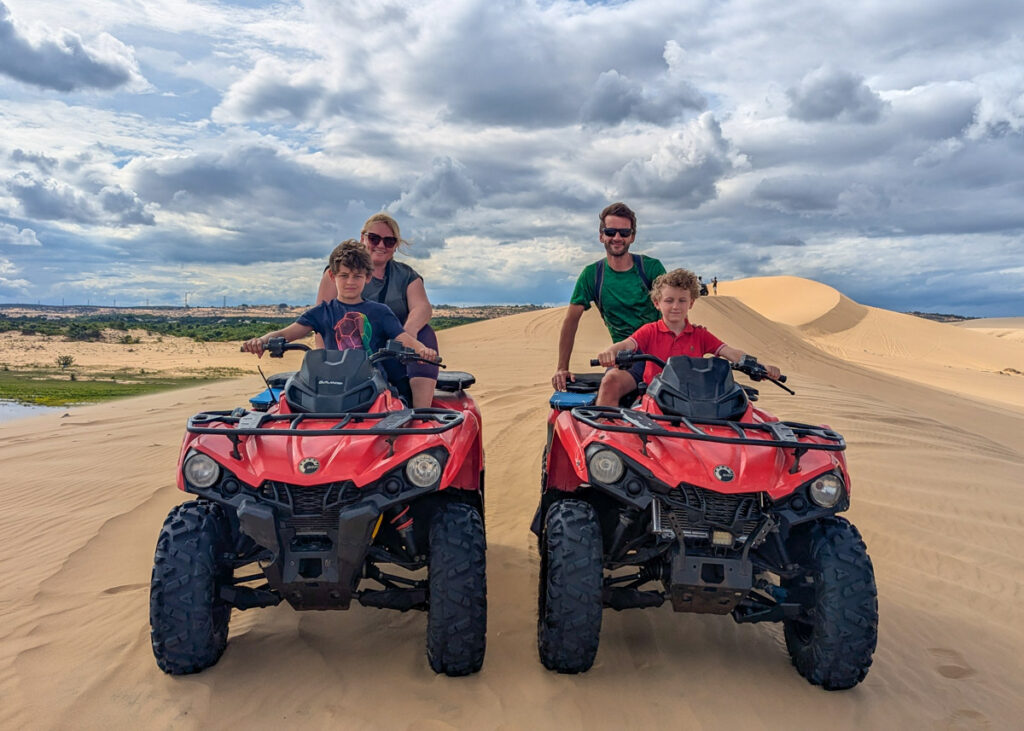
Known as a surf town, on arrival to Mui Ne, you may be rather disappointed by the beach; it has suffered terribly from coastal erosion. Indeed, there’s a forgotten and abandoned vibe and many families skip it on their itineraries. But if you want the kids to have some beach time and perhaps a surf, then it’s a worthwhile stop.
Surfing lessons are extortionately priced. Instead, head to this fishing beach south of Mui Ne where you can rent a board from a little shack on the beach. Even if you don’t want to surf or the conditions aren’t right, it’s the best beach in Mui Ne and worth the short Grab ride.
Mui Ne is also known for two incredible sand dune ecosystems. These can be visited on a Mui Ne Jeep Tour, and also includes the Fairy Stream (a one-kilometre long riverbed you can walk along, quite fun and fine to do barefoot)
Day 7-8: Dalat
READ: Dalat motorbike tour
Accommodation: Holly Hostel
Very basic, good location, very little English spoken.

The best way to experience Dalat is on a motorbike tour. You don’t have to drive the bikes yourself, instead you ride pillion with your guide (although please note that the minimum age is 5).
A tour typically take you to a flower farm, a Weasel poo coffee farm, a cricket farm, a silk worm factory, a giant Buddha, a waterfall, and to Chicken Village. It is brilliant fun and our boys very much enjoyed it.
Day 9-11: Nha Trang
READ: Nha Trang with kids
Accommodation: Intercontinental Residences
Splash out on a spacious apartment with superb ocean views and enjoy some downtime.
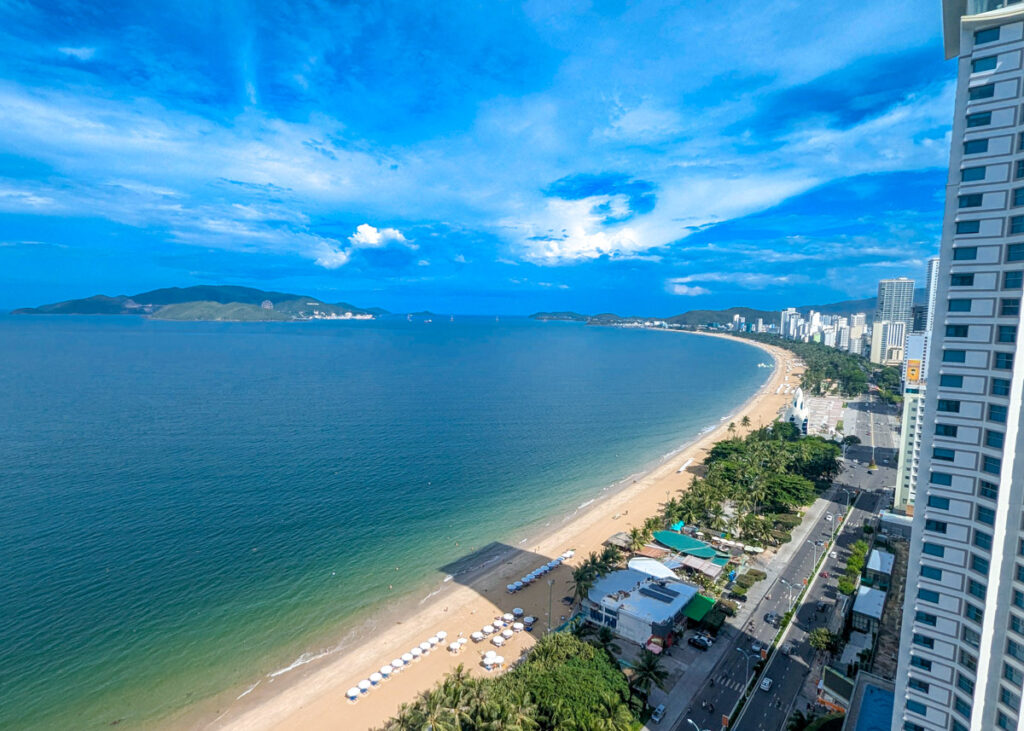
By this stage of the travels, you will need to take a breather and enjoy some downtime at a resort-style hotel and catch up on some washing (we recommend the Intercontinental Residences). Plus, if you want to experience a Vietnam sleeper train, Nha Trang is a useful stop as it’s from here you catch the train north to Danang (just a one hour drive from Hoi An).
We should mention though that Nha Trang isn’t everyone’s cup of tea. The beach is very impressive but there is little in the way of Vietnamese culture here and the clubs and bars sitting below the skyscrapers frequented by Russian tourists set a certain tone.
Some families may enjoy a snorkelling trip to nearby islands (although we didn’t fancy it with all the jellyfish) and a visit to Vinpearl, one of Vietnam’s largest theme parks situated on the main island across from the bay. For us Vinpearl was too busy and rather expensive for the poor quality of rides. Younger kids who prefer tamer rides may get more out of it.
Our recommendation would be to book in to something a bit nicer for a couple of nights, and then take the sleeper train up to Danang. Enjoy the downtime.
Day 12-15: Hoi An
READ: Hoi An with kids
Accommodation: Bon Sand Villa & Spa Hoi An
Tucked down a small lane on an island on the river and beautifully peaceful. The family who run it are beautiful humans and we loved the balcony view over the river. What a special find!
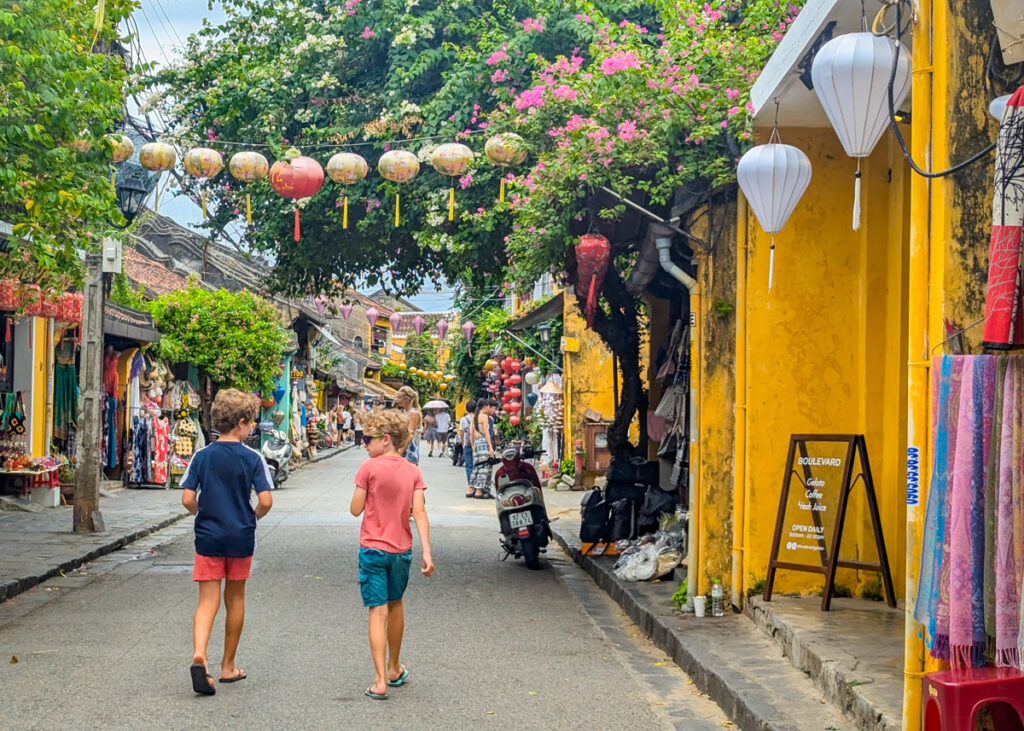
We actually spent eight days in Hoi An, and this really didn’t feel too long. Indeed, Hoi An has become a popular worldschooling destination and some travelling families stay for months at a time. So if you do have few spare days up your sleeve, it’s worth using them here.
One of the reasons this historic riverside town is popular with worldschooling families is that there are so many things to do in Hoi An with kids; from playing at the An Bang Beach, making lanterns or clay pots, cruising along the river and the coconut plantations, a day trip to My Son Temples, and enjoying the night markets, to name a few. Click here to check out our guide.
Although be prepared, Hoi An is no longer the sleepy backpacker destination you may have visited in your pre-kids backpacking days. The secret is well and truly out, and tourism is booming, especially with the Asian market. Indeed, the Old Town can feel way too busy in the evenings, and for this reason, we recommend staying in the surrounding countryside. We absolutely loved our stay at Bon Sand Villa & Spa Hoi An.
Day 16: Hoi An to Hue motorbike tour
READ: Hoi An to Hue motorbike tour
Accommodation: Golden Star Villa Hue
Nothing special, but it was clean, had a small pool, and the location is fine: away from the hustle of the city centre but still only a few minutes away in a Grab. Included breakfast, but not a very good one.

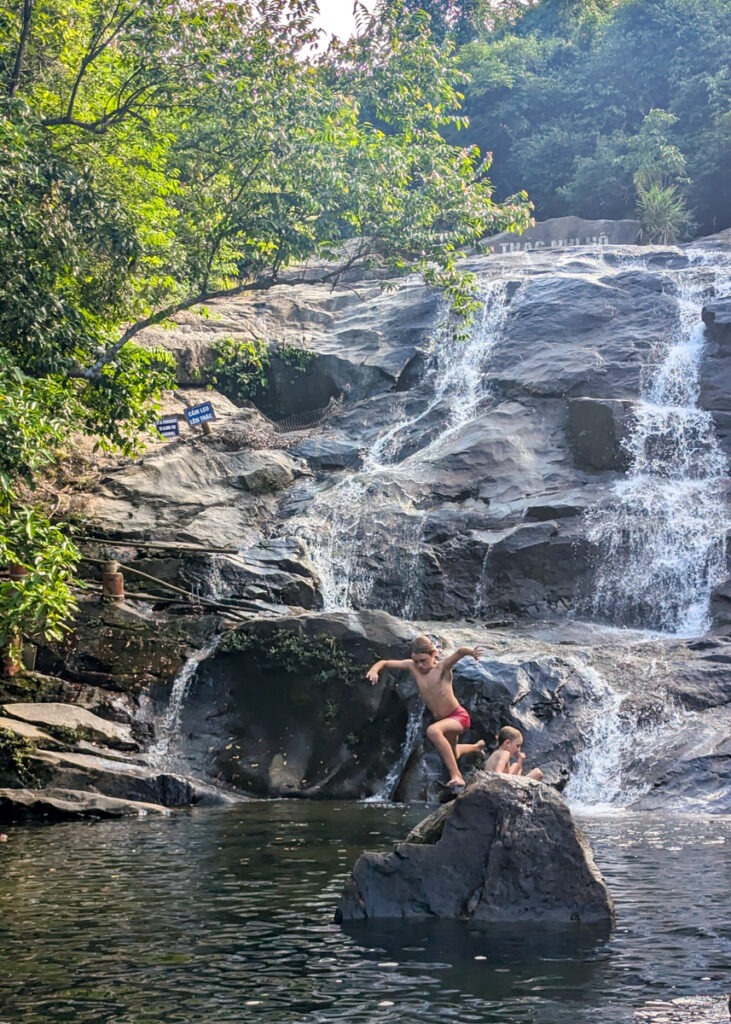
It’s possible to get a bus to Hue, but you’d be missing out on some of Vietnam’s most spectacular scenery. Instead, we recommend doing a Hoi An to Hue motorbike tour. This takes in the sights of Danang (including Marble Mountain and the Dragon Bridge), the spectacular Hai Van Pass, a swim at a stunning waterfall (Thác Nhị Hồ), and finishes the day at an mysterious abandoned waterpark before riding straight to your Hue accommodation.
This was one of our absolute highlights travelling Vietnam with kids. The views from the back of the bike are literally ‘once-in-a-lifetime’ moments, and seeing the kids ride ahead with the emerald sea in the background is parenting paradise.
Day 17-18: Hue
READ: Hue with kids
Accommodation: Golden Star Villa Hue
Nothing special, but it was clean, had a small pool, and the location is fine: away from the hustle of the city centre but still only a few minutes away in a Grab. Included breakfast, but not a very good one.
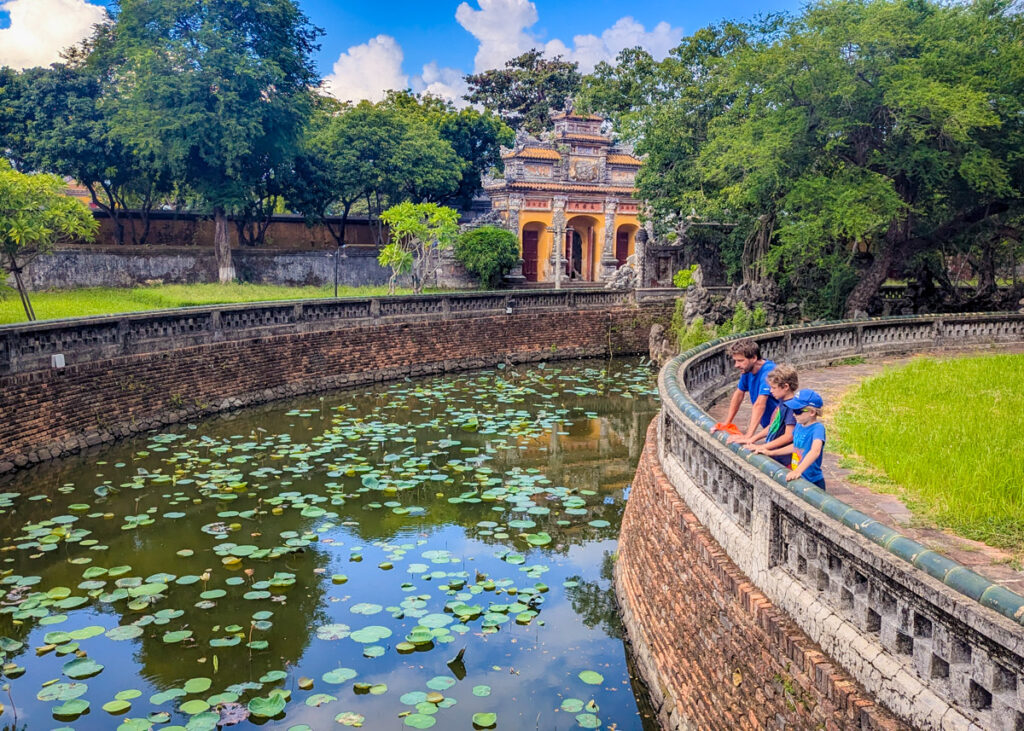
The imperial city of Hue isn’t on every travelling family’s radar, perhaps because at first glance, the sights aren’t obviously kid-friendly. There’s some element of truth in that as Hue is all about heritage sites focused on the Imperial City and Emperor Tombs dotted around the outskirts of town.
A visit needs a carefully planned approach to keep the whinges at bay. It’s important to remember you won’t be able to do it all, so we recommend just doing the Imperial City (visit later in the day when the weather is cooler) and Mausoleum of Emperor Khai Dinh the following morning. It’s one of the quieter tombs, yet still offers impressive architecture.
Day 19-21: Phong Nha
READ: Phong Nha with kids
Accommodation: Phong Nha Green Homestay
Really lovely room and the rooftop pool offers great views (rather unclean though). The owner is very eager and full of life, but there is a big push here to book tours.
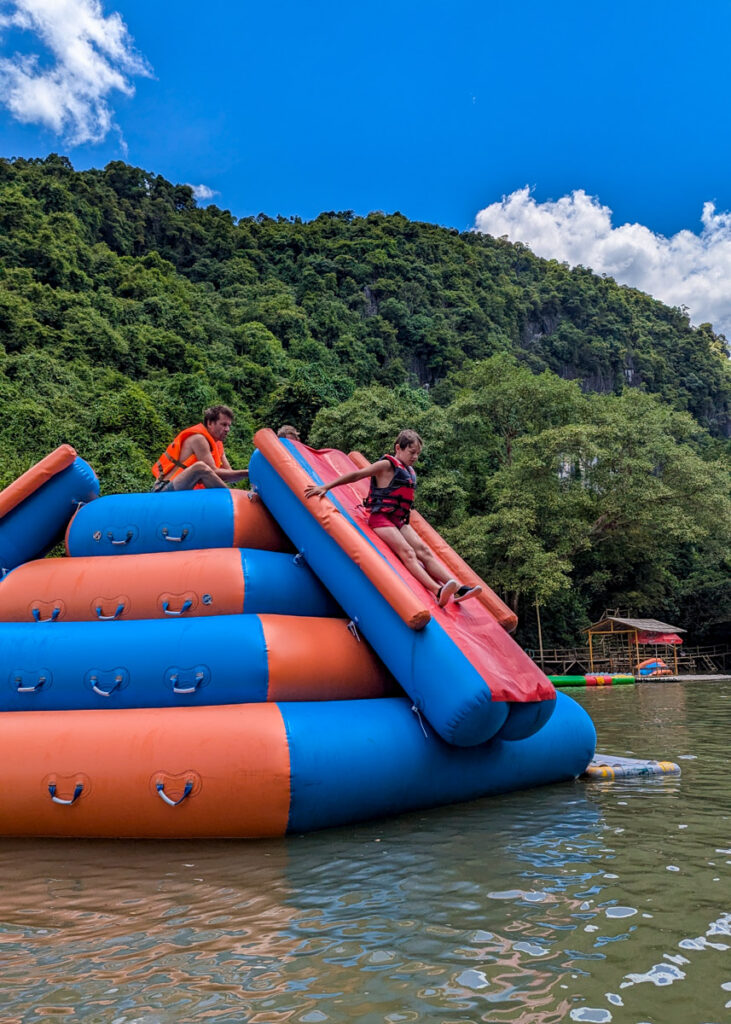
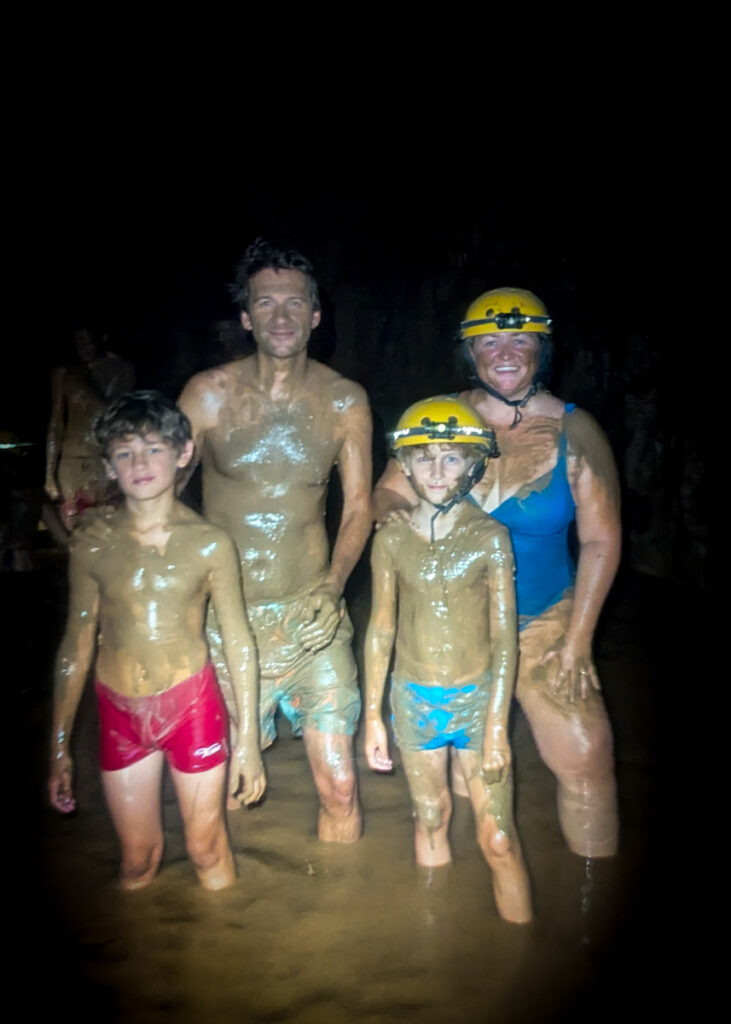
Phong Nha styles itself as one of the adventure capitals of Vietnam and the town centre certainly occupies a dramatic location, with limestone peaks towering over the main street. A large independent traveller enclave has been carved out here, with most of the buildings on the main road housing either restaurants, guesthouses or tour agencies.
Tour booking is big business and you’ll be gently pestered throughout your stay to book something or other. On day 1, it’s easy enough to visit the closest cave to the town centre (known as Phong Nha Cave) independently via the boats from the dock a few minutes walk away. Your boat will take you into the caves, make sure you keep your head down as the engines are switched off and you drift along the river.
On your second day, the two most famous caves are a short drive away, which can be organised through your accommodation or one of the tour agencies. You’ll visit the awe-inspiring Paradise Cave first, the scale of which can only be appreciated in person, although it also makes for epic photographs.
The final stop is Dark Cave (also known as Mud Cave) where the kids will love kayaking to the cave, finding their way though pitch black tunnels with only headtorches for guidance, taking an impromptu mud bath, before kayaking back to the water-based adventure playground where they can either swing on ropes, zip-line across the water, or bounce around on the giant inflatables.
Day 22-24: Ninh Binh
READ: Ninh Binh with kids
Accommodation: Trang An Family Homestay
Quiet, family-run accommodation. Owners speak very little English. Rooms clean with central pool.
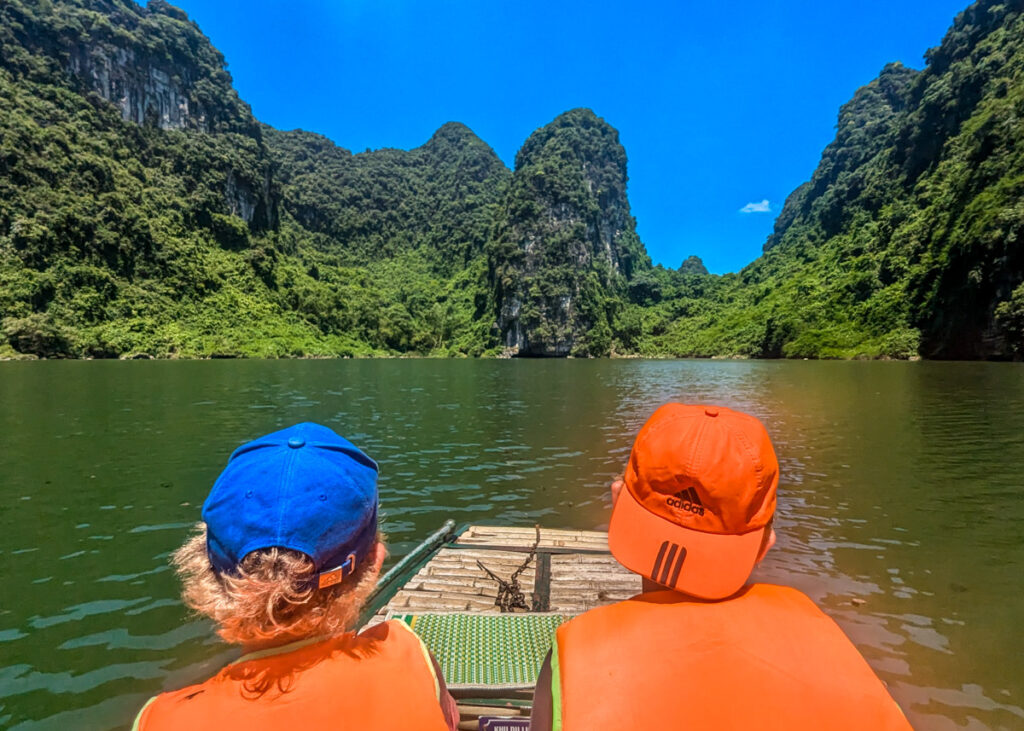
Easily reached from Phong Nha on a long (but direct) daytime sleeper bus, Ninh Binh is split into two distinct areas of Tam Coc and Trang An. Most visitors spend their time relaxing by the river and booking onto one of the beautiful boat tours that leave from either side of town.
Our recommendation is to take a boat trip from Trang An as it’s a picturesque stretch of water to drift along, although arrive as early as possible as it can get exceptionally busy with tour groups. There’s no shade on the boats so, if you arrive early morning, you’ll also escape some of the heat. Umbrellas are provided though and are most welcome when you’re not sheltered in the cave system.
The guides are friendly ladies who row the boats towards and through the caves, stopping off at several temples along the way. It’s an incredibly idyllic location and takes around three hours in total to complete. Tips at the end are appreciated.
Trang An has some quiet local restaurants serving a mix of western and Asian dishes, otherwise head over to Tam Coc if you want more choice and a slightly livelier atmosphere. Some of the bars and restaurants have a fun backpacker vibe but are still welcoming of families. It’s an ideal spot to crack open a beer, pull up a chair with a view of the river, and play cards or board games with the kids.
Day 25-26: Hanoi
READ: Hanoi with kids
Accommodation: Hanoi Center Silk Lullaby Hotel and Travel
Clean and a step up from ‘basic’. Excellent location.
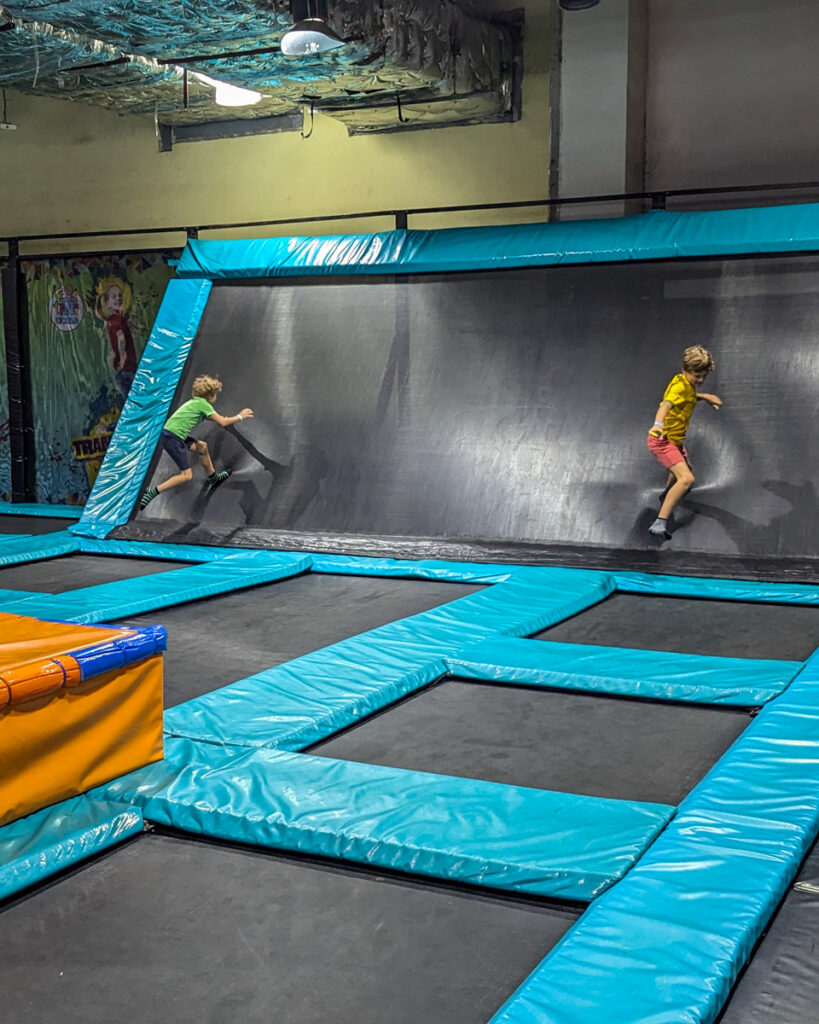
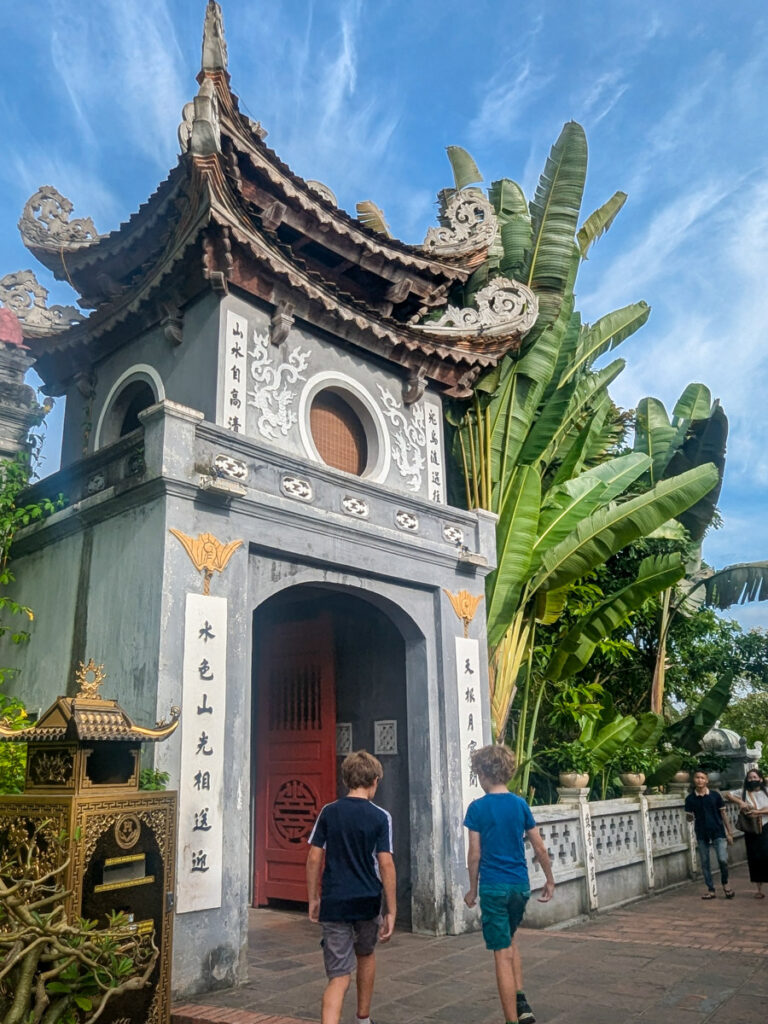
Loud, chaotic, and busy, Hanoi can be a challenging city to visit with kids, especially little ones. Crossing the road will give parents palpitations and you’re constantly on your guard for approaching mopeds as you meander down alleyways. Add in the honking horns, weaving around obstructions on pavements, and you begin to see why Hanoi with kids isn’t always plain sailing.
However, this is a city bursting with energy and colour, offering a good balance of culture, activities, and Western comforts to keep all the family happy, and everyone finds themselves passing through Hanoi at some point.
With this Vietnam itinerary, you only have one full day in Hanoi, as the other is spent travelling. Spend your time walking alongside Hoàn Kiếm Lake towards the Old Quarter, passing Thang Long Water Puppet Theatre en route to purchase tickets for an evening performance. In the afternoon, visit Hoa Lo Prison Relic and Train Street.
If you do have another day spare, take the kids to either the indoor play centre at Tini World at Aeon Mall Long Bien or to VinWonders Wave Park & Water Park on the outskirts of Hanoi, because travelling with kids is all about balance, right?
Day 27-29: Halong Bay
READ: Halong Bay with kids
Accommodation: Dragon 2 with Indochina Junk
Cabins are beautifully decorated, with wood-panelling and attractive artwork on the walls. The double bed (the boys had a twin room) easily wins the award for most-comfortable bed on our Vietnam travels.
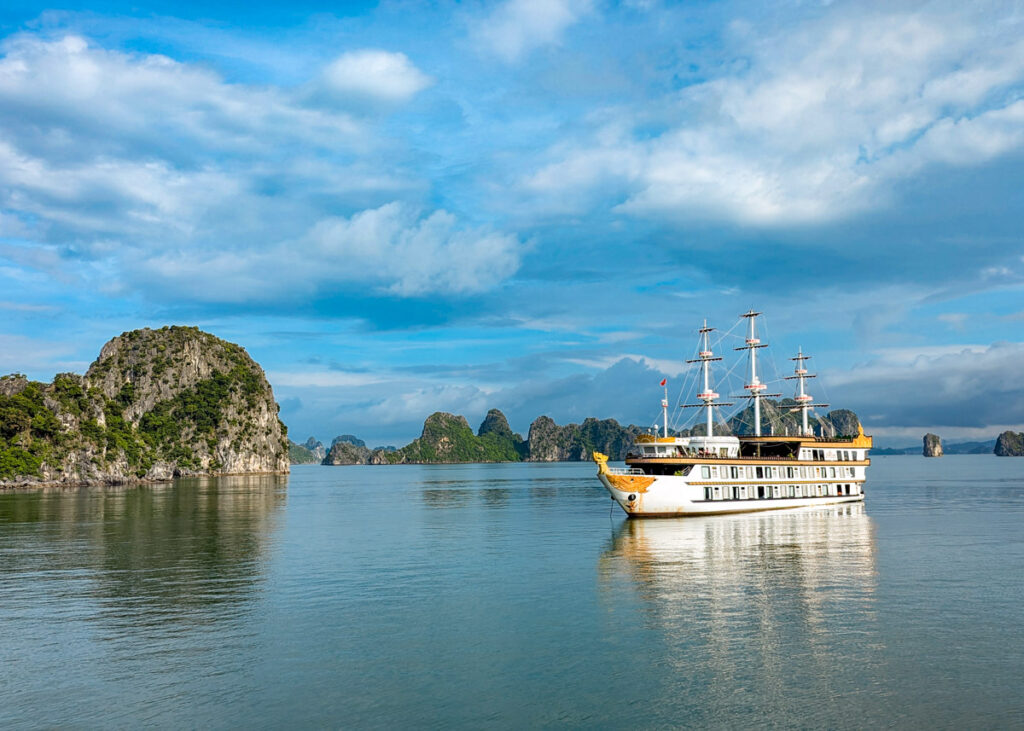
A Halong Bay cruise is a highlight of any trip to Vietnam, but you may have heard stories of the awful pollution of the water and the congestion of tourist vessels.
Thankfully, we experienced very little in the way of plastic pollution (far less than we had anticipated) and it only felt congested towards the start of the tour. We put this down to our choice of cruise, Indochina Junk, which offers a smaller boat and takes you ‘off the beaten track’ (as much as you can in one of Vietnam’s most visited tourist destinations).
You can read our full review here, but our 3D/2N included return minibus travel from Hanoi, all meals, and two cabins (you can get adjoining family rooms, but these had already been taken when it came to booking).
There are a number of activities that you can do during the cruise (see the below list). These are all optional, but our favourite was the kayaking.
- Thien Canh Son Cave
- Kayaking at Cap La
- BBQ lunch on a secluded beach
- Bamboo boat ride around Vung Vieng fishing village
- Squid fishing after dinner from the back of the ship
- Tai Chi on the sundeck each morning at 6am
You will need another night in Hanoi between leaving Halong Bay and arriving to Sapa. That is unless you take the night train. However, we recommend taking the bus the following day.
Day 30-33: Sapa
READ: Sapa with kids
Accommodation: Stone Paradise Homestay
The terrace views from our room are why we loved this accommodation so much. The family room is basic, but comfortable, and the bathroom is across the terrace.
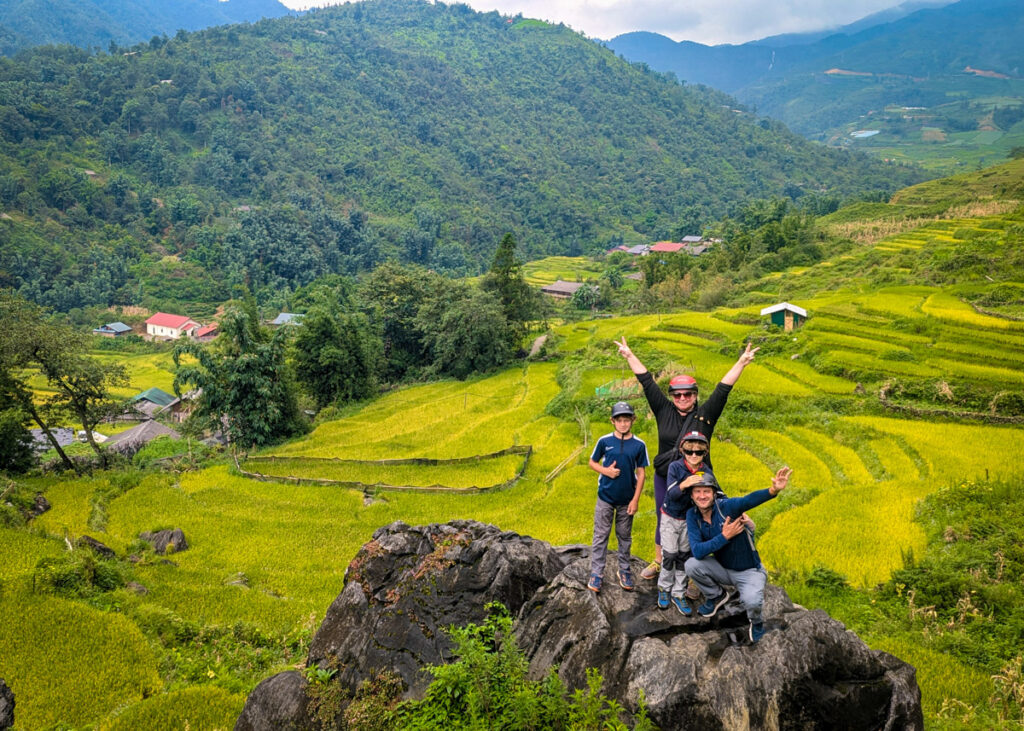
Sapa was our favourite destination on our Vietnam with kids travels. Which is funny, as we’d almost missed it after other travellers had told us how busy it was with tour buses.
But the secret to visiting Sapa is to not stay in Sapa. We found a beautiful homestay in the countryside, Stone Paradise Homestay, about 15 minutes drive from the main town. From here you can go on an independent trek through the villages and rice paddies (you don’t need to pay for a guide). We actually split this Sapa trek into two separate day treks.
A visit to Fansipan via the cable car, tallest mountain in the region formerly known as Indochina, is an absolute must. Just be prepared for a drop in temperature. Plus a motorbike half day tour to venture further into the countryside and to swim at Love Waterfall (we arranged this through our homestay).
We loved the cooler mountain air, the lush views, and a quieter life after many destinations in Vietnam feeling exceptionally busy. There’s also a good range of restaurants in the main town should you need some variety to your diet at this stage of the travels.
Day 34-35: Hanoi
READ: Hanoi with kids
Accommodation: Old Town Palace Guest House
Small and cramped, but clean and cheap.
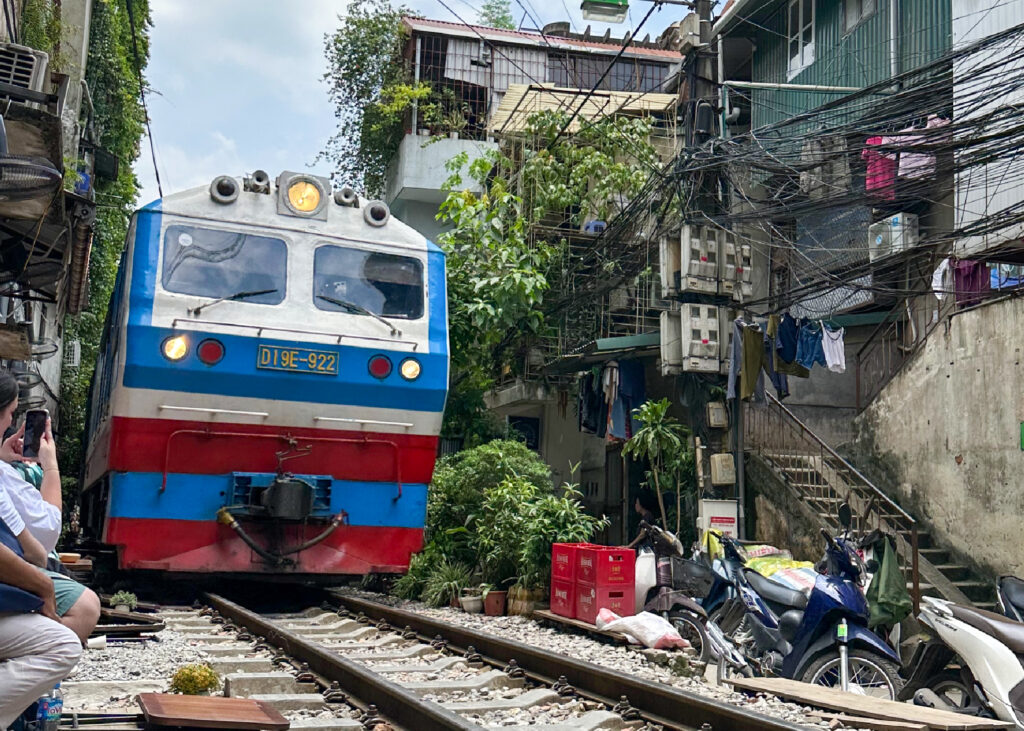
And that’s a wrap on our Vietnam with kids itinerary from HCMC to Hanoi. With a day spare, perhaps visit Ho Chi Minh’s Mausoleum and Temple of Literature, or instead just head to a bar, order all your favourite food from the trip, and toast your adventures over a few drinks.
Vietnam destination guides for families
Here are some links to our other destination guides to Vietnam for further research:
General Vietnam with kids guides:
- 14 sanity-saving tips for visiting Vietnam with kids
- North or South Vietnam: where to visit if you have to choose
- Riding a Vietnam sleeper train: what to expect and how to book
South Vietnam guides:
- Ho Chi Minh City with kids: top 12 things to do in and around the city
- 10 day South Vietnam itinerary: including accommodation and transport options
- Visiting Cu Chi Tunnels without a tour (you can use Grab!)
- Visiting the War Remnants Museum, HCMC, with kids
- Visiting Mui Ne, Vietnam: sand dunes, surfing and our stay at Joe’s Café
- Mui Ne Jeep Tour REVIEW: is it worth doing?
- Dalat motorbike tour: the BEST way to explore Dalat with kids
Central Vietnam guides:
- Nha Trang with kids: is this the one place to skip on your Vietnam trip?
- Hoi An with kids: things to do, tips, and where to stay
- Hue with kids: taking it in manageable bitesize chunks
- Hoi An to Hue motorbike day tour with Easyriders: REVIEW
North Vietnam guides:
- Hanoi with kids: top 10 things to do and where to stay
- Halong Bay with kids: the BEST cruise for families
- Visiting Sapa with kids: the essential guide for backpacking families
- Sapa trekking without a guide: yes, it’s possible and here’s how to do it
- Visiting Fansipan, Sapa, via cable car: everything you need to know
Vietnam stories on Instagram
If you would like to get more of a visual idea of what to expect travelling Vietnam with kids, you can head over to our Instagram where, in the Highlights section, we have saved stories from our Vietnam travels. There are four separate Vietnam Highlights:
- Vietnam I (HCMC to Nha Trang)
- Vietnam II (Nha Trang to Hoi An)
- Vietnam III (Hoi An to Hanoi)
- Vietnam IV (Hanoi to Halong Bay to Hanoi to Sapa to Hanoi)
You may also like to read:
Thailand with kids travel guide
Malaysia with kids travel guide
Cambodia with kids travel guide

